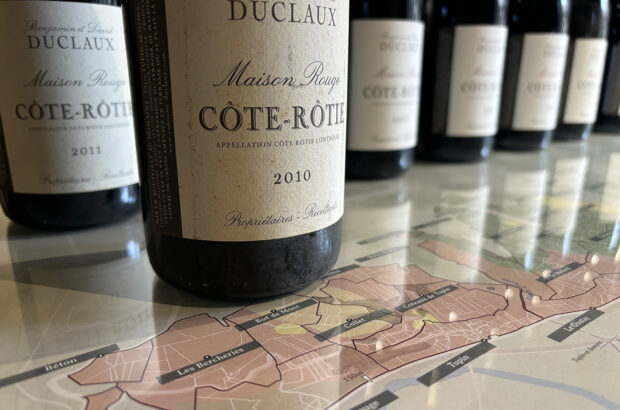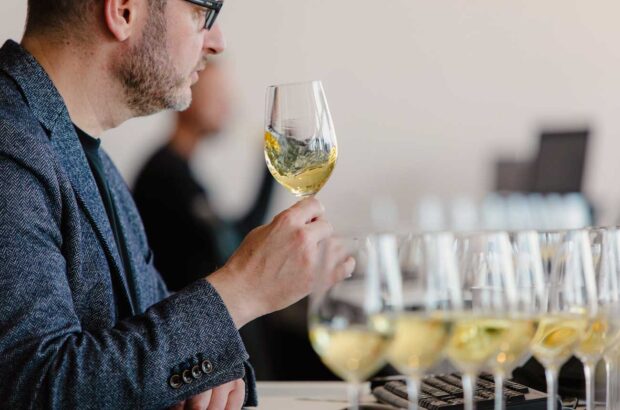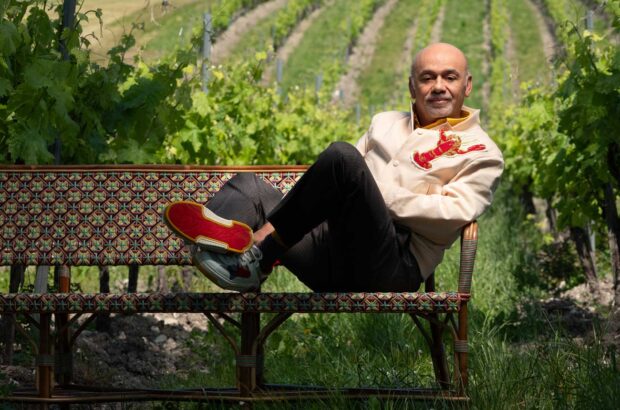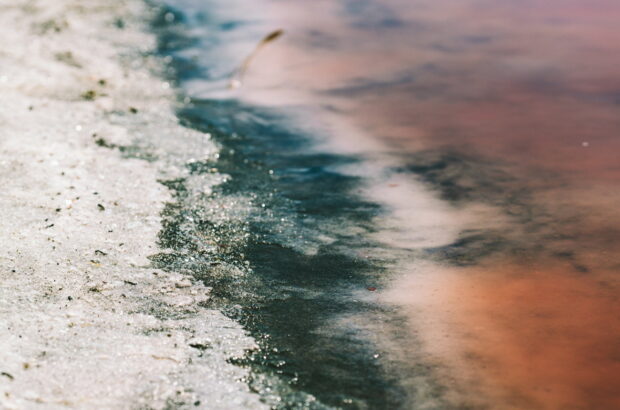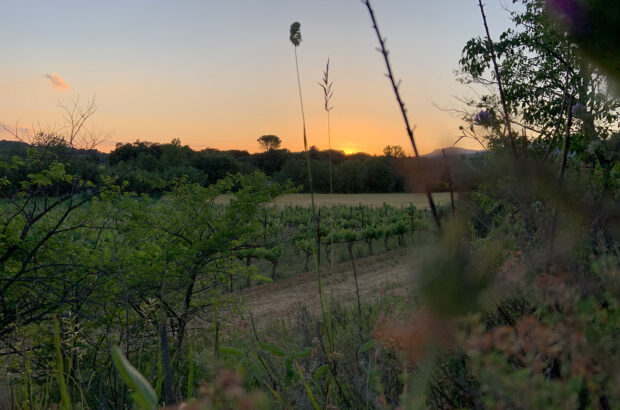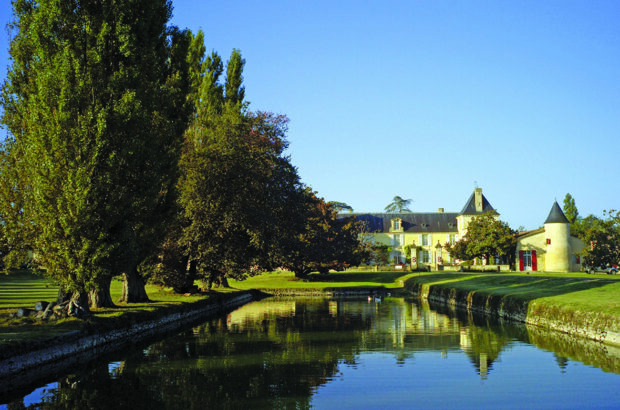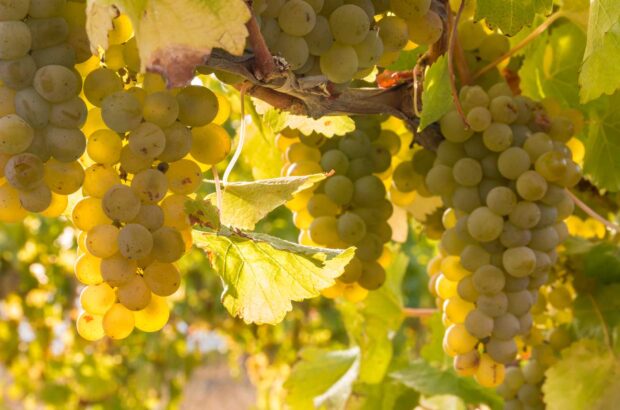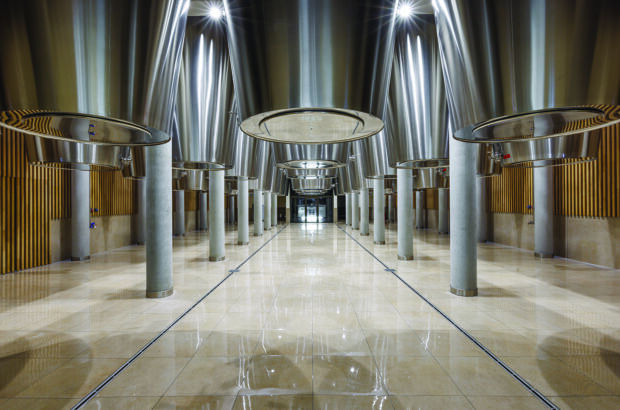Terroir is one of those buzz-words that everyone in the wine world embraces, but what does it really mean? And does it really have the effect on wines that producers claim? Rupert Joy digs deep to find out
Terroir is one of those buzz-words that everyone in the wine world embraces, but what does it really mean? And does it really have the effect on wines that producers claim? Rupert Joy digs deep to find out
South of Condrieu in the northern Rhône lies the tiny appellation of Château-Grillet. Its 3.4 hectares of vines on the steep slopes of a natural amphitheatre produce minute quantities of wine from the same grape variety and soils as its much larger neighbour, Condrieu. But it has been recognised since 1936 as a separate AC, and sells for far more. Its owner, Isabelle Baratin-Canet, stresses that the originality of the wine made from its granite soils and south-facing exposure has been recognised for centuries. But some of her neighbours question whether there is such a difference between the terroirs of Château-Grillet and Condrieu.
The idea that particular patches of land produce particularly great wines is not new. The philosopher, John Locke, who visited Bordeaux in 1677, noted the ‘particularity in the soil’ of Château Haut-Brion that distinguished it from its neighbours. A book by Abbot Arnoux, published in London in 1728, attributed the greatness of Montrachet in Burgundy to a particular strip of earth on the Côte d’Or.
What is a modern phenomenon is the use of the word ‘terroir’ to describe the idea. Its original French connotations were pejorative. Until the mid-20th century, a vin terroité meant a rustic, earthy wine with, at best, a sort of yokel charm and, at worst, faults. A wine with a goût de terroir (flavour of terroir) was a shoddily made wine that tasted of unripe or rotten grapes. The idea of terroir as a more positive attribute did not emerge until the birth of the AC system in the 1930s.
Everyone has his own definition of terroir. Perhaps the simplest is that of American wine writer Matt Kramer, who describes it as ‘somewhereness’. Most French definitions, including that of the INAO (the body responsible for France’s AC system), include four key elements: the physical characteristics of a place (especially soil and exposure), its climate, the grape variety used and the role played by man.
Few people would dispute the basic premise that wines derive certain characteristics from the place where their grapes are grown, and that man plays a role in expressing those characteristics. But given that just about every wine producer these days claims to produce wines that respect terroir, and claims to take a ‘non-interventionist’ approach, the consumer has every reason to wonder what terroir means in practice.
The roots of terroir
Perhaps because the word is similar to ‘terrain’, we tend to associate terroir mainly with soil. This in turn can encourage the perception that wines directly derive a taste from the soil in which they are grown.
A classic example is Chablis, one of the world’s most recognisable wines. Despite being made from a ubiquitous grape variety, the Chablis expression of Chardonnay is unlike that from any other region. The most reputed wines come from soft Kimmeridgian chalky marl, composed of prehistoric oyster shells.
Producers and wine writers often make a link between the wine’s characteristic flinty-iodine taste and the region’s geology. ‘How else can you explain the iodised notes in Chablis if not by the composition of its soil?’ asks Bernard Billaud-Simon. ‘You don’t find this taste in Chardonnays grown elsewhere.’
{"content":"PHA+VGhpcyBub3Rpb24gaXMgY2hhbGxlbmdlZCBieSBzY2llbnRpc3RzLiBUYXNtYW5pYS1iYXNlZCB2aXRpY3VsdHVyaXN0IFJpY2hhcmQgU21hcnQgaXMgZm9ydGhyaWdodDog4oCYSXTigJlzIG5vbnNlbnNlIHRvIGltYWdpbmUgdmluZXMgY2FuIGFzc2ltaWxhdGUgYW55dGhpbmcgbW9yZSB0aGFuIHNpbXBsZSBjaGVtaWNhbCBlbGVtZW50cyBmcm9tIHRoZSBzb2lsIGFuZCB1cCBpbnRvIHRoZSBncmFwZS4gSW4gQ2hhYmxpcywgdGhlIGZsaW50eSB0YXN0ZSBjYW4gYmUgYXNzb2NpYXRlZCB3aXRoIGFjaWRpdHkuIFRoaXMgaXMgY2F1c2VkIGJ5IGRpZmZlcmVuY2VzIGluIGNsaW1hdGUsIHByaW1hcmlseSB0ZW1wZXJhdHVyZS4gQW5kIGlmIHlvdSB3YW50IHRvIGNhbGwgaXQgdGVycm9pciwgdGhhdOKAmXMgZmluZS4gVGhlIHRoaW5nIHRoYXTigJlzIGltcG9ydGFudCBhYm91dCBzb2lsIGlzIGl0cyBhYmlsaXR5IHRvIGhvbGQgd2F0ZXIu4oCZS2VlcyB2YW4gTGVldXdlbiBvZiBDaMOidGVhdSBDaGV2YWwgQmxhbmMgYWdyZWVzOiDigJhJZiB0aGVyZSBzZWVtcyB0byBiZSBhIGxpbmsgYmV0d2VlbiB0aGUgbWluZXJhbHMgaW4gdGhlIHNvaWwgYW5kIHRoZSB0YXN0ZSBvZiBDaGFibGlzLCBpdCBtdXN0IGJlIGluZGlyZWN0LiBUaGUgdGFzdGUgaXMgbW9yZSBsaWtlbHkgdG8gYmUgYW4gZWZmZWN0IG9mIHRoZSB2aW5leWFyZHPigJkgZXhwb3N1cmUgYW5kIGxhbmRzY2FwZS7igJnigJhHb8O7dCBkZSB0ZXJyb2lyIGRvZXMgbm90IG1lYW4gdGhlIHRhc3RlIG9mIGVhcnRoLOKAmSBzYXlzIEZyYW5jZeKAmXMgbGVhZGluZyB3aW5lIHdyaXRlciBNaWNoZWwgQmV0dGFuZS4g4oCYRGlmZmVyZW50IGdlb2xvZ2ljYWwgb3JpZ2lucyBpbmZsdWVuY2UgdGhlIHNoYXBlIGFuZCB0ZXh0dXJlIG9mIHdpbmUsIGFuZCBpdHMgYmFsYW5jZSBpbiB0ZXJtcyBvZiBzdWdhciwgYWNpZGl0eSBhbmQgdGFubmlucywgbW9yZSB0aGFuIGl0cyB0YXN0ZS7igJk8L3A+CjxwPk5ldmVydGhlbGVzcywgbWFueSBwcm9kdWNlcnMgaW5zaXN0IG9uIHRoZSByb2xlIG9mIHNvaWwgdHlwZSBpbiB3aW5lIHRhc3RlLiBBbm5lLUNsYXVkZSBMZWZsYWl2ZSwgd2hvIG1ha2VzIGV4dHJhb3JkaW5hcmlseSBldGhlcmVhbCwgaW50ZW5zZSB3aGl0ZSB3aW5lcyBpbiBQdWxpZ255LU1vbnRyYWNoZXQsIGluc2lzdHM6IOKAmEVsaW1pbmF0ZSBhbGwgdGhlIHZhcmlhYmxlcyBhbmQgeW914oCZbGwgc2VlIGNsZWFyIGRpZmZlcmVuY2VzIGJldHdlZW4gd2luZXMgcHJvZHVjZWQgZnJvbSB2aW5lcyAxMDBtIGFwYXJ0LiBIZXJlIHdlIGhhdmUgYSBzaW5nbGUgZ3JhcGUgdmFyaWV0eSBncm93biBvbiBtb3JlIG9yIGxlc3MgaG9tb2dlbm91cyBzb2lsIHR5cGVzLiBBbGwgb3VyIGdyYXBlcyBhcmUgaGFydmVzdGVkIGF0IHJvdWdobHkgdGhlIHNhbWUgdGltZSBhbmQgdmluaWZpZWQgYW5kIGFnZWQgaW4gdGhlIHNhbWUgd2F5LiBUaGUgYmlnIGRpZmZlcmVuY2VzIGJldHdlZW4gcGFyY2VscyBzZWVtIHRvIGxpZSBpbiB0aGUgc29pbCBzdHJ1Y3R1cmUgYW5kIHRoZSBjbGF5IHN1YnNvaWxzLuKAmTwvcD4KPGRpdiBjbGFzcz0iYWQtY29udGFpbmVyIGFkLWNvbnRhaW5lci0tbW9iaWxlIj48ZGl2IGlkPSJwb3N0LWlubGluZS01IiBjbGFzcz0iaXBjLWFkdmVydCI+PC9kaXY+PC9kaXY+CjxwPkNsYXVkZSBCb3VyZ3VpZ25vbiwgd2hvIGhhcyBzcGVudCBtYW55IHllYXJzIHdvcmtpbmcgb24gdGhlIG1pY3JvYmlvbG9naWNhbCBhY3Rpdml0eSBvZiB0aGUgc29pbCwgaXMgaW4gbm8gZG91YnQgdGhhdCBnZW9sb2d5IGhhcyBhbiBpbmZsdWVuY2Ugb24gd2luZSB0YXN0ZSBhbmQgY29sb3VyLiDigJhDaGFyZG9ubmF5IGdyb3duIGluIENoYWJsaXMgZ2l2ZXMgYSB5ZWxsb3ctZ3JlZW4gd2luZSwgYnV0IGEgeWVsbG93IHdpbmUgaW4gTW9udHJhY2hldC4gQ2hhbXBhZ25lcyBmcm9tIEtpbW1lcmlkZ2lhbiBzb2lsIGluIHRoZSBBdWJlIGhhdmUgYSBkaWZmZXJlbnQgdGFzdGUgZnJvbSBDaGFtcGFnbmVzIG1hZGUgb24gTWFybmUgY2hhbGsuIEEgTXVzY2FkZXQgZ3Jvd24gb24gZ3Jhbml0ZSB0YXN0ZXMgZGlmZmVyZW50IGZyb20gYSBNdXNjYWRldCBncm93biBvbiBnbmVpc3Mu4oCZPC9wPgo8aDI+TGl2ZSBlYXJ0aDwvaDI+CjxwPkJvdWd1aWdub24gYmVsaWV2ZXMgbWljcm8tb3JnYW5pc21zIGluIHRoZSBzb2lsLCBpbiBwYXJ0aWN1bGFyIHNvaWwgZnVuZ2kgY2FsbGVkIG15Y29ycmhpemFlLCBhcmUgdGhlIGtleSB0byB0ZXJyb2lyIGV4cHJlc3Npb24uIOKAmEl04oCZcyBiYWN0ZXJpYSB0aGF0IGVuYWJsZSB0aGUgdmluZeKAmXMgcm9vdHMgdG8gYXNzaW1pbGF0ZSBudXRyaWVudHMuIFNvIGl04oCZcyBpbXBvc3NpYmxlIHRvIGRpc3Rpbmd1aXNoIGJldHdlZW4gd2luZXMgZnJvbSBkaWZmZXJlbnQgdGVycm9pcnMgaWYgdGhlIHNvaWwgaXMgYmlvbG9naWNhbGx5IGRlYWQuIFRoYXTigJlzIHdoeSB0aGUgcm9sZSBvZiB0ZXJyb2lyIGRpdmlkZXMgc2NpZW50aXN0cy4gVGhleSBuZXZlciBjaGVjayB0aGUgbGV2ZWwgb2YgYmlvbG9naWNhbCBhY3Rpdml0eSBpbiB0aGUgc29pbC7igJk8L3A+CjxwPk5pY29sYXMgSm9seSwgYSBsZWFkaW5nIGV4cG9uZW50IG9mIGJpb2R5bmFtaWMgdml0aWN1bHR1cmUsIGFncmVlczog4oCYTm8gcm9vdHMgY2FuIGRlcml2ZSBub3VyaXNobWVudCBmcm9tIHRoZSBzb2lsIHdpdGhvdXQgYSB3aWRlIGRpdmVyc2l0eSBvZiBtaWNyby1vcmdhbmlzbXMuIFRoZXkgYWN0IGFzIHJlbGF5cywgdHJhbnNtaXR0aW5nIGVhY2ggc3VidGxldHkgb2YgYSBzb2ls4oCZcyBnZW9sb2d5LuKAmTwvcD4KPHA+RnJhbsOnb2lzIFBlcnJpbiBvZiBCZWF1Y2FzdGVsIGluIENow6J0ZWF1bmV1Zi1kdS1QYXBlLCB3b25kZXJzIGlmIHRoZSBsb2NhbCBjaGFyYWN0ZXIgb2YgdGhlc2Ugc29pbCBtaWNyby1vcmdhbmlzbXMgbWlnaHQgY29udHJpYnV0ZSB0byBnb8O7dCBkZSB0ZXJyb2lyLiBIZSB0b28gaXMgY29udmluY2VkIHRoYXQgbGl2aW5nIHNvaWwgaXMgYSBrZXkgdG8gZ3JlYXQgdGVycm9pci4g4oCYVGhlcmUgYXJlIGNsZWFyIGRpZmZlcmVuY2VzIGJldHdlZW4gdGhlIG1pbmVyYWwgcXVhbGl0aWVzIG9mIHdpbmVzIG1hZGUgZnJvbSBsaXZpbmcgYW5kIGRlYWQgc29pbHMu4oCZPC9wPgo8cD5CdXJndW5keSBpcyBhdCB0aGUgaGVhcnQgb2YgdGhlIG5vdGlvbiBvZiB0ZXJyb2lyLiBJdHMgaGllcmFyY2hpY2FsIHN5c3RlbSBpcyBiYXNlZCBhcm91bmQgdGhlIHByaW5jaXBsZSB0aGF0IGRpZmZlcmVudCB2aW5leWFyZCBzaXRlcywgb2Z0ZW4gb25seSBhIGZldyBtZXRyZXMgYXBhcnQsIHByb2R1Y2Ugd2luZXMgdGhhdCB2YXJ5IHN1YnN0YW50aWFsbHkgaW4gcXVhbGl0eS48L3A+CjxwPkJ1dCBKZWFuLUZyYW7Dp29pcyBCYXppbiwgYXV0aG9yIG9mIG51bWVyb3VzIGJvb2tzIG9uIEJ1cmd1bmR5LCBwb2ludHMgb3V0IHRoYXQgdGhlcmUgaXMgYWxzbyBhIGdvb2QgZGVhbCBvZiBoaXN0b3JpY2FsIGFjY2lkZW50IHVuZGVybHlpbmcgdGhpcyBoaWVyYXJjaHk6IOKAmFRoZSByZWFzb24gdGhlcmUgYXJlIG5vIGdyYW5kcyBjcnVzIGluIEJlYXVuZSwgU2F2aWdueSwgUG9tbWFyZCwgVm9sbmF5IGFuZCBNZXVyc2F1bHQgaXMgdGhhdCBCZWF1bmXigJlzIGFsbC1wb3dlcmZ1bCBuw6lnb2NpYW50cyB3YW50ZWQgdG8ga2VlcCB0aGVpciBtYXJxdWVzLuKAmTwvcD4KPHA+RmV3IGV4cGVydHMgZGlzcHV0ZSB0aGF0LCBvdmVyYWxsLCB0aGUgaGllcmFyY2h5IHJlZmxlY3RzIHdpbmUgcXVhbGl0eSwgYW5kIHRoYXQgdGhlIHRydWx5IGdyZWF0IHRlcnJvaXJzIOKAkyB3aGF0IEJldHRhbmUgY2FsbHMgdGVycm9pcnMgY2hhaXNlIGxvbmd1ZSDigJMgcHJvZHVjZSBncmVhdCB3aW5lIGV2ZXJ5IHllYXIsIGhvd2V2ZXIgdGhleSBhcmUgd29ya2VkLiBBdCBhbiBlY29ub21pYyBsZXZlbCwgdGhpcyBpcyBib3JuZSBvdXQgYnkgdGhlIHByaWNlIGRpZmZlcmVuY2VzIGJldHdlZW4gZ2VuZXJpYyBCdXJndW5keSwgdmlsbGFnZSB3aW5lcywgcHJlbWllcnMgY3J1cyBhbmQgZ3JhbmRzIGNydXMsIGFzIHdlbGwgYXMgYnkgaHVnZSBkaWZmZXJlbmNlcyBpbiB0aGUgcHJpY2Ugb2Ygdml0aWN1bHR1cmFsIHJlYWwgZXN0YXRlLiBTbyB3aGF0LCBpbiBwcmFjdGljYWwgdGVybXMsIG1ha2VzIHRoZSBkaWZmZXJlbmNlPzwvcD4KPHA+4oCYVGhlIGdyYW5kcyBjcnVzIGFuZCB0aGUgcHJlbWllcnMgY3J1cyBhcmUgaW5jb250ZXN0YWJseSB0aGUgYmVzdCBzaXRlcyzigJkgc2F5cyBBdWJlcnQgZGUgVmlsbGFpbmUgb2YgRG9tYWluZSBkZSBsYSBSb21hbsOpZS1Db250aS4g4oCYVGhleSBhcmUgYWx3YXlzIHNpdHVhdGVkIGluIHRoZSDigJxwYWxt4oCdIG9mIHRoZSBzbG9wZSwgdGhlIG1pZGRsZSBvZiB0aGUgaGlsbHNpZGUgd2hlcmUgdGhlcmUgaXMgYW4gYWNjdW11bGF0aW9uIG9mIGVhcnRoLCBhbiBpbmNsaW5lLCBnb29kIGRyYWluYWdlIGFuZCB0aGVyZWZvcmUgaWRlYWwgaHlkcmF1bGljIGNvbmRpdGlvbnMgZm9yIHRoZSB2aW5lIOKAkyBpbiBvdGhlciB3b3JkcywgaW4gZXhhY3RseSB0aGUgY29uZGl0aW9ucyB0aGF0IG1lYW4gZ3JlYXQgcXVhbGl0eSBpbiBCdXJndW5keS7igJk8L3A+CjxwPlRoZSBzdXBwbHkgb2Ygd2F0ZXIgdG8gdGhlIHZpbmUgaXMgY2xlYXJseSBjcml0aWNhbC4gUHJvZHVjZXJzIG9mdGVuIG9ic2VydmUgdGhhdCB3aW5lcyBwcm9kdWNlZCBmcm9tIGxpbWVzdG9uZSBzb2lscyBoYXZlIGEg4oCYbWluZXJhbOKAmSBxdWFsaXR5LCB3aGlsZSB3aW5lcyBmcm9tIGNsYXkgc29pbHMgYXJlIHJpY2hlciBhbmQgbW9yZSBvcHVsZW50LiBCdXQgdGhpcyBtYXkgaGF2ZSBsZXNzIHRvIGRvIHdpdGggdGhlIGNoZW1pY2FsIGNvbXBvc2l0aW9uIG9mIHRoZSBzb2lsIHRoYW4gdGhlIGZhY3QgdGhhdCBsaW1lc3RvbmUgc29pbHMgYXJlIHRoaW5uZXIgYW5kIHJldGFpbiBsZXNzIHdhdGVyLCBleHBvc2luZyB0aGUgdmluZXMgdG8gZ3JlYXRlciB3YXRlciBzdHJlc3MuIFJlc2VhcmNoIGJ5IEfDqXJhcmQgU2VndWluIG9mIEJvcmRlYXV4IFVuaXZlcnNpdHkgc2VlbXMgdG8gc3VnZ2VzdCB0aGF0IHNvaWwgc3RydWN0dXJlIGFuZCBkcmFpbmFnZSBhcmUgdGhlIGNvbnNpc3RlbnQgZmFjdG9yIGluIGdyZWF0IHRlcnJvaXJzLjwvcD4KPHA+U3R1ZGllcyBieSBTZWd1aW4gYW5kIHZhbiBMZWV1d2VuIHN1Z2dlc3QgdGhhdCB0aGVyZSBpcyBubyBxdWFsaXR5IGxpbmsgYmV0d2VlbiBzcGVjaWZpYyBzb2lscyBhbmQgZ3JlYXQgd2luZXMuIOKAmEluIEJvcmRlYXV4LCB0b3Agd2luZXMgYXJlIHByb2R1Y2VkIG9uIHNvaWxzIGFzIGRpZmZlcmVudCBhcyBhbGthbGluZSBsaW1lc3RvbmUgc29pbHMgKEF1c29uZSksIGFjaWRpYyBncmF2ZWxseSBzb2lscyAoTGFmaXRlKSwgbmV1dHJhbCBncmF2ZWxseSBzb2lscyAoQ2hldmFsIEJsYW5jKSBhbmQgaGVhdnkgY2xheSBzb2lscyAoUMOpdHJ1cykuIEl0IGlzIGdlbmVyYWxseSBub3QgcG9zc2libGUgdG8gZXF1YXRlIGEgc29pbCBtYXAgb2YgYSBnaXZlbiByZWdpb24gd2l0aCBhIG1hcCBvZiBxdWFsaXR5IHBvdGVudGlhbCBmb3Igd2luZS1ncm93aW5nLuKAmTwvcD4KPHA+TmFkaW5lIEd1YmxpbiBvZiBEb21haW5lIEphY3F1ZXMgUHJpZXVyIGlzIGNvbnZpbmNlZCB0aGF0IG1pY3JvY2xpbWF0ZSwgZXNwZWNpYWxseSB2aW5lIGV4cG9zdXJlLCBpcyBrZXkuIOKAmExhc3QgU2VwdGVtYmVyIEkgd2FzIGF0IE1ldXJzYXVsdCBvbmUgZXZlbmluZy4gVGhlIHZpbmVzIHdlcmUgaW4gc2hhZGUsIHRoZSB0ZW1wZXJhdHVyZSB3YXMgMjDCukMgYW5kIHRoZSBncmFwZXMgYWxyZWFkeSBjb2xkLiBPdmVyIHRoZSBoaWxsLCBhIGZldyBtaW51dGVzIGF3YXksIHRoZSB2aW5lcyBpbiBQdWxpZ255LU1vbnRyYWNoZXQgd2VyZSBzdGlsbCBpbiBmdWxsIHN1bnNoaW5lLCB0aGUgdGVtcGVyYXR1cmUgd2FzIDI1wrpDIGFuZCB0aGUgZ3JhcGVzIHdlcmUgdmVyeSB3YXJtLiBJdOKAmXMgYSBwZXJmZWN0IGV4YW1wbGUgb2YgdGVycm9pciBpbiBhY3Rpb24u4oCZPC9wPgo8aDI+VGhlIGh1bWFuIHRvdWNoPC9oMj4KPHA+SG93ZXZlciBtdWNoIHdlIG1pZ2h0IHdhbnQgdG8gdGhpbmsgb2Ygd2luZSBwcm9kdWN0aW9uIGFzIGEgbmF0dXJhbCBwcm9jZXNzLCBtYW5raW5kIHJlbWFpbnMgYXQgdGhlIGNlbnRyZSBvZiBpdC4gTm8gdmluZSB2YXJpZXRpZXMgY3VycmVudGx5IGdyb3duIHRvIG1ha2Ugd2luZSBleGlzdGVkIGluIG5hdHVyZS4gVGhlIGNob2ljZSBvZiBjbG9uZXMsIHBsYW50aW5nIGRlbnNpdHksIHZpbmUgdHJhaW5pbmcsIHBydW5pbmcgYW5kIG90aGVyIGFzcGVjdHMgb2YgdmluZXlhcmQgbWFuYWdlbWVudCBhcmUgYWxsIGluaGVyZW50bHkg4oCYdW5uYXR1cmFs4oCZLiDigJhUaGUgZ3JlYXQgdGVycm9pcnMgb2YgQnVyZ3VuZHkgaGF2ZSBhbGwgYmVlbiB3b3JrZWQgb24gYW5kIGRldmVsb3BlZCBmb3IgY2VudHVyaWVzLOKAmSBzYXlzIEplYW4tQml6b3Qgb2YgVm9zbmUtUm9tYW7DqWUuIOKAmERyYWluYWdlIGhhcyBiZWVuIGluc3RhbGxlZCwgZXJvZGVkIHNvaWxzIGNhcnJpZWQgYmFjayB1cCB0aGUgc2xvcGVzLiBUaGlzIG1ha2VzIGEgYmlnIGRpZmZlcmVuY2Uu4oCZPC9wPgo8cD5BbmQgdGhhdOKAmXMgYmVmb3JlIHRoZSBncmFwZXMgZXZlbiByZWFjaCB0aGUgY2VsbGFyLiBFdmVuIGF0IGl0cyBsZWFzdCDigJhpbnRlcnZlbnRpb25pc3TigJksIHZpbmlmaWNhdGlvbiByZXF1aXJlcyBhIHJhbmdlIG9mIGRlY2lzaW9ucyB0aGF0IGFmZmVjdCB3aW5lIHN0eWxlLiBUd28geWVhcnMgYWdvLCByZXNlYXJjaGVycyBWaWN0b3IgR2luc2J1cmdoIGFuZCBPbGl2aWVyIEdlcmdhdWQgcHVibGlzaGVkIGEgc3R1ZHkgdGhhdCBhdHRlbXB0ZWQgdG8gcXVhbnRpZnkgdGhlIHJlbGF0aXZlIGVmZmVjdHMgb2YgdGVycm9pciBhbmQgdGVjaG5vbG9neSBvbiBwZXJjZWl2ZWQgd2luZSBxdWFsaXR5LiBUaGUgcmVzdWx0cywgdGhleSBjbGFpbWVkLCBzdWdnZXN0IOKAmHdpbmVtYWtpbmcgaGFzIGJlY29tZSBzbyBzb3BoaXN0aWNhdGVkIHRoYXQgaXQgY2FuIGNvbXBsZXRlbHkgc2hhZGUgdGhlIGVmZmVjdCBvZiB0ZXJyb2ly4oCZLjwvcD4KPHA+VGhleSBhcmUgbm90IGFsb25lIGluIGFyZ3VpbmcgdGhhdCBwcm9kdWNlcnMgcGxheSBhIG1vcmUgc2lnbmlmaWNhbnQgcm9sZSB0aGFuIHRlcnJvaXIgaW4gc2hhcGluZyB3aW5lLiBWaW5pZmljYXRpb24gc3R5bGUg4oCTIHdoYXQgdGhlIEZyZW5jaCBjYWxsIHRoZSBjb3VwIGRlIHBhdHRlIChoZWxwaW5nIGhhbmQpIG9mIHRoZSBwcm9kdWNlciDigJMgaXMgdW5kZW5pYWJseSBjcml0aWNhbCBpbiBpbmZsdWVuY2luZyB0aGUgZmluYWwgcHJvZHVjdC4g4oCYVGVycm9pciBzcGVha3MgaW4gYSB2ZXJ5IHN0aWxsLCBzbWFsbCB2b2ljZSzigJkgc2F5cyBSYW5kYWxsIEdyYWhtLiDigJhJdCBpcyBlYXN5IG5vdCB0byBoZWFyIGl0IGFib3ZlIHRoZSBzdGVudG9yaWFuIHRvbmVzIG9mIDEwMCUgbmV3IG9haywgMTUlIGFsY29ob2wgYW5kIHRoZSBleHRyZW1lIHRhbm5pYyBleHRyYWN0aW9uIHRoYXQgd2UgZmluZCBpbiBtb2Rlcm4gd2luZXMu4oCZPC9wPgo8cD5JbiBCb3JkZWF1eCBpbiBwYXJ0aWN1bGFyLCB0aGUgcXVhbGl0eSBvZiBtYW55IHdpbmVzIGhhcyByYWRpY2FsbHkgaW1wcm92ZWQgYXMgYSByZXN1bHQgb2YgaGVhdnkgaW52ZXN0bWVudCBhbmQgdGVjaG5pY2FsIGFkdmljZS4gSmVhbi1HdWlsbGF1bWUgUHJhdHMgb2YgQ2jDonRlYXUgQ29zIGTigJlFc3RvdXJuZWwgc2VlcyB0ZXJyb2lyIGFuZCB0ZWNobm9sb2d5IGFzIGNvbXBsZW1lbnRhcnkuIOKAmFRoZSB2aW5zIGRlIGdhcmFnZSBwaGVub21lbm9uIHNob3dlZCB0aGF0IHdpdGggaW52ZXN0bWVudCBhbmQgYXR0ZW50aW9uIHRvIGRldGFpbCwgZ29vZC1xdWFsaXR5IHdpbmVzIGNhbiBiZSBtYWRlIG9uIHNvaWxzIG5vdCBwcmV2aW91c2x5IHJlY29nbmlzZWQgYXMgZ29vZCB0ZXJyb2lycy4gQnV0IHdoZXJlIGxvbmctc3RhbmRpbmcgZG9tYWluZXMgd2l0aCBncmVhdCB0ZXJyb2lycyBtYWRlIHNpbWlsYXIgaW1wcm92ZW1lbnRzLCB0aGV54oCZdmUgbWFkZSBiZXR0ZXIgd2luZXMgdGhhbiBldmVyLiBUb2RheeKAmXMgQ29zIGlzIG1vcmUgY29uY2VudHJhdGVkIGFuZCBleHByZXNzaXZlIG9mIHRoZSB0ZXJyb2lyIHRoYW4gQ29zIDQwIHllYXJzIGFnby7igJk8L3A+CjxwPkFuZHJldyBKZWZmb3JkLCBhdXRob3Igb2YgVGhlIE5ldyBGcmFuY2UsIGFncmVlczog4oCYSeKAmWQgc2F5IHRoYXQgdGVycm9pciBuZWVkcyBnb29kIHdpbmVtYWtpbmcgdG8gYmVjb21lIGFydGljdWxhdGUuIElmIHlvdeKAmXJlIG5vdCBtYWtpbmcgdGhlIHJpZ2h0IHdpbmVtYWtpbmcgZGVjaXNpb25zLCB5b3Ugd29u4oCZdCBnZXQgYSB2ZXJ5IGZ1bGwgdGVycm9pciBpbXByaW50LiBUaGUgY2xhc3NpYyBleGFtcGxlIGlzIFBvbWVyb2wuIE9ubHkgMTAwIHllYXJzIGFnbywgbm8gb25lIHRvb2sgaXQgc2VyaW91c2x5LiBOb3cgaXRzIHdpbmVzIGFyZSBzb3VnaHQgYWZ0ZXIgYW5kIGl0IGhhcyBkaXN0aW5jdGl2ZSB0ZXJyb2lycy4gTW9kZXJuIGFwcHJvYWNoZXMgaW4gQm9yZGVhdXggaGF2ZSBnaXZlbiB1cyBhIHdlbGNvbWUgc2Vuc2Ugb2YgYWVzdGhldGljIGRpdmVyc2l0eS4gV2hhdCB3ZeKAmXZlIGxvc3QgYXJlIHRoZSB3ZWVkeSwgZ3JlZW4sIHJvcGlseSBtYWRlIHdpbmVzIG9mIHRoZSAxOTYwcy03MHMu4oCZPC9wPgo8cD5UaGUgdHJ1dGggaXMgdGhhdCBubyBvbmUgcmVhbGx5IGtub3dzIGhvdyB0ZXJyb2lyIHdvcmtzLiBTZWd1aW4sIFNtYXJ0IGFuZCBvdGhlcnMgaGF2ZSBkb25lIG11Y2ggdG8gZGVmaW5lIHRoZSBrZXkgZWxlbWVudHMgaW4gc2NpZW50aWZpYyB0ZXJtcywgYnV0IHNjaWVuY2UgY2Fubm90IGV4cGxhaW4gZXZlcnl0aGluZy48L3A+CjxwPkhvd2V2ZXIgaGFyZCB0aGUgY29uY2VwdCBvZiB0ZXJyb2lyIGlzIHRvIHBpbiBkb3duLCB0aGVyZSBpcyBnZW5lcmFsIGFncmVlbWVudCBpbiBPbGQgYW5kIE5ldyBXb3JsZHMgdGhhdCB0ZXJyb2lyIGlzIHRoZSBhbnRpdGhlc2lzIG9mIHNvLWNhbGxlZCDigJhicmFuZGVkIHdpbmVz4oCZLCB3aGljaCBkZXJpdmUgY2hhcmFjdGVyIGZyb20gd2luZW1ha2luZyBwcm9jZXNzZXMgYW5kIGJsZW5kaW5nLiDigJhVbHRpbWF0ZWx5LOKAmSBzYXlzIFBhdWwgRHJhcGVyIG9mIENhbGlmb3JuaWHigJlzIFJpZGdlIFZpbmV5YXJkcywg4oCYcGVvcGxlIHdobyBsb3ZlIHdpbmUgc2VlIGEgY29ubmVjdGlvbiB0byB0aGUgZWFydGggd2hpY2gsIGluIHRoaXMgdmlydHVhbCB3b3JsZCwgd2UgYXJlIGluIGRhbmdlciBvZiBsb3NpbmcgZW50aXJlbHkuIEluIGEgd29ybGQgb2Ygc28gbWFueSBjb21tb2RpdHkgd2luZXMsIHdlIG11c3QgcmVtYWluIHRydWUgdG8gdGhhdC7igJk8L3A+CjxwPlRoZXJlIGlzIGFsc28gd2lkZXNwcmVhZCBhZ3JlZW1lbnQgdGhhdCB0ZXJyb2lyIGxpZXMgYXQgdGhlIGhlYXJ0IG9mIGdyZWF0IHdpbmUsIGV2ZW4gaWYgaXQgaXMgbm90IGFsd2F5cyBlYXN5IHRvIGV4cGxhaW4uIEd1Ymxpbiwgb25lIG9mIHRoZSBtb3N0IGFydGljdWxhdGUsIHN0cmFpZ2h0LXRhbGtpbmcgb2Vub2xvZ2lzdHMgeW91IGNhbiBtZWV0LCBpcyBhdCBhIGxvc3MgdG8gc2F5IHdoeSBNb250cmFjaGV0IG1ha2VzIHN1Y2ggc3VibGltZSB3aGl0ZSB3aW5lcy4g4oCYVGhlcmXigJlzIHNvbWV0aGluZyBleHRyYW9yZGluYXJ5IGFib3V0IHRoZSBzb2lsLiBJIGRvbuKAmXQga25vdyB3aGF0IGl0IGlzLCBidXQgaXQgcHJvZHVjZXMgd2hpdGUgd2luZXMgdGhhdCBnaXZlIHRoZSBpbXByZXNzaW9uIG9mIHRhbm5pbnMgaW4gdGhlIG1vdXRoLCBhcyBpZiBpdCB3ZXJlIGEgcmVkIHdpbmUu4oCZPC9wPgo8cD5JdOKAmXMgdGhhdCBteXN0ZXJpb3VzIHF1YWxpdHksIGl0cyBlbHVzaXZlIGNvbXBsZXhpdHksIHRoYXQgbWFrZXMgaXQgc28gZmFzY2luYXRpbmcuIFdlIG1heSBuZXZlciBmdWxseSB1bmRlcnN0YW5kIHRoZSBsaW5rIGJldHdlZW4gYSB3aW5l4oCZcyB0YXN0ZSBhbmQgaXRzIHRlcnJvaXIuIEFuZCwgaW4gYSB3YXksIEkgaG9wZSB3ZSBuZXZlciBkby48L3A+CjxwPlRob3VnaHRzIG9uIHRlcnJvaXI8L3A+CjxwPuKAmFRoZSBpbmZsdWVuY2Ugb2Ygc29pbCwgc3Vic29pbCwgd2VhdGhlciwgd2F0ZXIsIHN1biBhcmUgYWxsIG9iamVjdGl2ZS4gVGhlIHJlc3Qg4oCTIGdyYXBlIHZhcmlldHksIHJvb3RzdG9ja3MsIHZpbmV5YXJkIHdvcmssIGV0YyDigJMgYXJlIGEgcHJvZHVjdCBvZiBtYW4uIFRlcnJvaXIgY2Fubm90IGV4cGxhaW4gZXZlcnl0aGluZy4gSXQgY2xlYXJseSBleGlzdHMsIGJ1dCBpdOKAmXMgbm90IHRoZSBhbnN3ZXIgdG8gZXZlcnl0aGluZ+KAmTwvcD4KPHA+SmVhbi1GcmFuw6dvaXMgQmF6aW4sIHdpbmUgaGlzdG9yaWFuPC9wPgo8cD7igJhTY2llbmNlIGlzIHN0aWxsIGEgbG9uZyB3YXkgb2ZmIGJlaW5nIGFibGUgdG8gZGVmaW5lIHdoYXQgbWFrZXMgYSBncmVhdCB0ZXJyb2lyLiBJdOKAmXMgdGhlIHF1YWxpdHkgb2Ygd2luZSB0aGF0IHByb3ZlcyB0aGUgZ3JlYXRuZXNzIG9mIGEgdGVycm9pcjsgc2NpZW50aWZpYyBhbmFseXNpcyBzaW1wbHkgY29uZmlybXMgaXTigJk8L3A+CjxwPk1pY2hlbCBCZXR0YW5lLCB3aW5lIHdyaXRlcjwvcD4KPHA+4oCYVmluZXMgZG9u4oCZdCBjYXJlIHdoZXRoZXIgdGhleSBncm93IGluIEp1cmFzc2ljIG9yIEtpbW1lcmlkZ2lhbiBzb2lsOiB0aGV5IGp1c3Qgd2FudCBzb21ld2hlcmUgdG8gZml4IHRoZWlyIHJvb3RzLiBXaGF0IG1ha2VzIHRoZSBkaWZmZXJlbmNlIGluIGdyZWF0IHRlcnJvaXJzIGlzIHRoYXQgdGhleSBoYXZlIGJlZW4gd29ya2VkIG9uIGFuZCBwZXJmZWN0ZWQgYnkgbWFuIG92ZXIgbWFueSBjZW50dXJpZXPigJk8L3A+CjxwPkplYW4tWXZlcyBCaXpvdCwgQnVyZ3VuZHk8L3A+CjxwPuKAmFRvIG1ha2UgYSBncmVhdCB3aW5lLCB5b3UgbmVlZCBhIGdyZWF0IHRlcnJvaXIgdGhhdCBpcyBiaW9sb2dpY2FsbHkgYWN0aXZlLCBhIHZpbmUgYWRhcHRlZCB0byB0aGlzIHRlcnJvaXIgYW5kIGEgZ29vZCB3aW5lbWFrZXIuIEFsbCB0aHJlZSBhcmUgZXNzZW50aWFs4oCZPC9wPgo8cD5DbGF1ZGUgQm91cmd1aWdub24sIHNvaWwgc2NpZW50aXN0PC9wPgo8cD7igJhJIGFjY2VwdCB0aGF0IHRoZXJl4oCZcyBubyBzY2llbnRpZmljIGV2aWRlbmNlIHRvIHByb3ZlIHRoYXQgdGVycm9pciBleGlzdHMuIE1heWJlIHNjaWVuY2Ugd2lsbCBjYXRjaCB1cCBvbmUgZGF5IGFuZCBmaWd1cmUgaXQgYWxsIG91dC4gT3Igd2UgbWF5IG5ldmVyIGhhdmUgdGhlIHRvb2xzIHRvIHNheSB3aHkgY2VydGFpbiB3aW5lcyB0YXN0ZSB0aGUgd2F5IHRoZXkgZG8uIEJ1dCB0aGUgZW1waXJpY2FsIGV2aWRlbmNlIGlzIGNsZWFy4oCZPC9wPgo8cD5QYXVsIERyYXBlciwgQ2FsaWZvcm5pYTwvcD4KPHA+4oCYVGVycm9pciBpcyBub3Qgb25seSBhIG15dGgsIGl04oCZcyBhIGpva2XigJk8L3A+CjxwPlZpY3RvciBHaW5zYnVyZ2gsIGVjb25vbWlzdDwvcD4KPHA+4oCYSeKAmXZlIHlldCB0byBoZWFyIGEgY29udmluY2luZyBleHBsYW5hdGlvbiBmb3IgaG93IHNvaWwgY29tcG9uZW50cyBjYW4gZGlyZWN0bHkgYWx0ZXIgdGhlIGZsYXZvdXIgb2YgZ3JhcGVzIGFuZCBoZW5jZSB0aGUgZmluaXNoZWQgd2luZSYjODIzMDsgQSBmaW5pc2hlZCB3aW5lIGlzIGFsbW9zdCB1bnJlY29nbmlzYWJsZSBmcm9tIHRoZSBzdGFydGluZyBwb2ludCBvZiBmcmVzaGx5IHByZXNzZWQgZ3JhcGUganVpY2UuIEFuZCBiZXlvbmQgdGhhdCBwb2ludCwgdGVycm9pciBjYW4gaGF2ZSBubyBlZmZlY3TigJk8L3A+CjxwPkphbWllIEdvb2RlLCB3aW5lIHdyaXRlcjwvcD4KPHA+4oCYSSB0aGluayBvZiB0ZXJyb2lyIGFzIHRoZSBkZWdyZWUgb2Ygb3JnYW5pc2F0aW9uIG9mIGEgcGFydGljdWxhciBzaXRlLCBpZSBob3cgd2VsbCB0aGUgc2l0ZSBoYXMgc29sdmVkIHRoZSBwYXJ0aWN1bGFyIGlzc3VlcyB0aGF0IGEgZ3JhcGUgdmFyaWV0eSBvciB2YXJpZXRpZXMgbWlnaHQgZmFjZS4gR3JlYXQgdGVycm9pcnMgc29tZWhvdyBzb2x2ZSB0aGVzZSBpc3N1ZXMgbW9yZSDigJxlbGVnYW50bHnigJ3igJk8L3A+CjxwPlJhbmRhbGwgR3JhaG0sIENhbGlmb3JuaWE8L3A+CjxwPuKAmFdoZXJldmVyIHlvdSBncm93IHBhcnRpY3VsYXIgZ3JhcGUgdmFyaWV0aWVzIGluIHBhcnRpY3VsYXIgcGxhY2VzLCBhbmQgbWFrZSB0aGUgd2luZSBpbiBhIHJlbGF0aXZlbHkgc2ltcGxlLCBzdHJhaWdodGZvcndhcmQgd2F5LCB0aGVuIHlvdSBoYXZlIGFuIGV4cHJlc3Npb24gb2YgdGVycm9pcuKAmTwvcD4KPHA+QW5kcmV3IEplZmZvcmQsIHdpbmUgd3JpdGVyPC9wPgo8cD7igJhUZXJyb2lyIGlzIGxpa2UgYSBtdXNpY2FsIGluc3RydW1lbnQuIFVubGVzcyB5b3Uga25vdyBob3cgdG8gbWFrZSB1c2Ugb2YgaXQsIGl04oCZcyB1c2VsZXNzLiBJZiB5b3UgaGF2ZSBhIGdvb2QgbXVzaWNpYW4gKHZpdGljdWx0dXJpc3QpLCBhIGdvb2QgbXVzaWNhbCBpbnN0cnVtZW50ICh0ZXJyb2lyKSBhbmQgZ29vZCBhY291c3RpY3MgKGFncmljdWx0dXJlKSwgdGhlcmXigJlzIG5vdGhpbmcgdG8gZG8gaW4gdGhlIGNlbGxhcuKAmTwvcD4KPHA+Tmljb2xhcyBKb2x5LCBTYXZlbm5pw6hyZXM8L3A+CjxwPuKAmFRoZXJl4oCZcyBubyBzY2llbnRpZmljIHByb29mIGZvciB0eXBpY2l0eTogeW91IGNhbuKAmXQgZGVzY3JpYmUgaXQgaW4gbW9sZWN1bGFyIHRlcm1zLiBCdXQgeW91IGNhbiBzZWUgaXQgYXQgd29yayBpbiBhbiBhcHBlbGxhdGlvbiBsaWtlIFN0LUVtaWxpb24uIFNvbWUgc29pbHMgYXJlIGxpbWVzdG9uZSwgc29tZSBhcmUgZ3JhdmVsIGFuZCBzb21lIGFyZSBjbGF5LiBUaGUgd2luZXMgZnJvbSBhbGwgdGhyZWUgY2FuIGJlIGdvb2QsIGJ1dCB0aGUgdHlwaWNpdHkgaXMgcXVpdGUgZGlmZmVyZW50IGluIGVhY2ggY2FzZeKAmTwvcD4KPHA+S2VlcyB2YW4gTGVldXdlbiwgQm9yZGVhdXg8L3A+CjxwPuKAmFdpbmUgcHJvZHVjdGlvbiBpcyBhbGwgYWJvdXQgbGliZXJhdGluZyB0aGUgZW5lcmd5IGluIHRoZSBncmFwZXMgaW50byB0aGUgd2luZS4gVGhlIHByb2JsZW0gd2l0aCBOZXcgV29ybGQgcHJvZHVjZXJzIGlzIHRoYXQgdGhleSBtYWtlIHdpbmVzIHRoYXQgYXJlIGRlYWQsIHdpbmVzIHdpdGggbm8gZW5lcmd5IGxlZnTigJk8L3A+CjxwPkphY3F1ZXMgTGFyZGnDqHJlLCBCdXJndW5keTwvcD4KPHA+4oCYWW91IGNhbuKAmXQgdGFrZSBtYW4gb3V0IG9mIHRlcnJvaXIuIEl04oCZcyBsaWtlIGEgcm91Z2ggZGlhbW9uZCwgd2FpdGluZyB0byBiZSBkaXNjb3ZlcmVkIGFuZCBwZXJmZWN0ZWQgYnkgaHVtYW4gaW50ZWxsaWdlbmNl4oCZPC9wPgo8cD5GcmFuw6dvaXMgUGVycmluLCBDaMOidGVhdW5ldWYtZHUtUGFwZTwvcD4KPHA+4oCYUG9vciB2aW50YWdlcyB0ZW5kIHRvIGV4cHJlc3MgdGVycm9pciBiZXR0ZXIgdGhhbiBncmVhdCB2aW50YWdlcy4gSW4gcG9vciB5ZWFycywgdGhlIG9ubHkgdGhpbmcgeW91IGNhbiB0YXN0ZSBpcyB0aGUgdGVycm9pcjsgaW48L3A+CjxwPmdyZWF0IHllYXJzLCB5b3UgaGF2ZSB0byB3YWl0IGxvbmdlciBmb3IgdGhlIHRlcnJvaXIgaW4gd2luZXMgdG8gZXhwcmVzcyBpdHNlbGbigJk8L3A+CjxwPkVtbWFudWVsIFJleW5hdWQsIENow6J0ZWF1bmV1Zi1kdS1QYXBlPC9wPgo8cD7igJhNaW5lcmFsaXR5IGhhcyBubyBzY2llbnRpZmljIG5hbWUgYnV0IHBsYXlzIGEga2V5IHJvbGUuIEl04oCZcyB0aGUga2V5IHRocmVhZCBydW5uaW5nIHRocm91Z2ggZ3JlYXQgd2luZSDigJMgYW5kIGl0IGNvbWVzIGZyb20gdGhlIHNvaWzigJk8L3A+CjxwPkplYW4tTG91aXMgQ2hhdmUsIEhlcm1pdGFnZTwvcD4KPHA+4oCYV2l0aG91dCB0ZXJyb2lyLCBhIHdpbmUgaGFzIG5vIHNvdWwsIGhvd2V2ZXIgZ29vZCBpdCBtaWdodCBiZS4gVGVycm9pciBpcyB0aGUgY2VudHJhbCBjb3JlIGFyb3VuZCB3aGljaCBhIHdpbmUgb3JnYW5pc2VzIGFuZCBiYWxhbmNlcyBpdHNlbGYuIEEgd2luZSBjYW4gb25seSBiZSBncmVhdCBpZiBpdCBpcyBtYWRlIHRvIHRyeSB0byBleHByZXNzIHRlcnJvaXIgYXMgcGVyZmVjdGx5IGFzIHBvc3NpYmxl4oCZPC9wPgo8cD5BdWJlcnQgZGUgVmlsbGFpbmUsIEJ1cmd1bmR5PC9wPgo8cD7igJhBcyBsb25nIGFzIHlvdSB3b3JrIGluIGhhcm1vbnkgd2l0aCBuYXR1cmUsIHlvdSBjYW4gZmluZCB0ZXJyb2lycyBhbGwgb3ZlciB0aGUgd29ybGQgdGhhdCBwcm9kdWNlIGdyZWF0IHdpbmVzLiBUaGUgcm9sZSBvZiB0aGUgcHJvZHVjZXIgaXMgdG8gYWN0IGFzIGEga2luZCBvZiBtdXNpY2lhbiwgaW50ZXJwcmV0aW5nIHRoZSBtdXNpYyBvZiB0aGUgdGVycm9pcnPigJk8L3A+CjxwPkFubmUtQ2xhdWRlIExlZmxhaXZlLCBCdXJndW5keTwvcD4KPHA+4oCYSSBkb27igJl0IGJlbGlldmUgaW4gbWFnaWNhbCBjb21iaW5hdGlvbnMgb2Ygc29pbCBhbmQgZ3JhcGUgdmFyaWV0eS4gU29pbCBpcyBpbXBvcnRhbnQgdG8gdmluZXMgb25seSBpbiB0ZXJtcyBvZiBpdHMgcHJvcGVydGllcyB0byBhYnNvcmIgYW5kIHJldGFpbiBtb2lzdHVyZS4gSWYgaXQgd2VyZSBub3QgZm9yIGpvdXJuYWxpc3RzLCB2aW5leWFyZCBzb2lscyB3b3VsZCBuZXZlciBoYXZlIGJlZW4gZWxldmF0ZWQgdG8gdGhlIHN0YXR1cyB0aGV5IGhhdmXigJk8L3A+CjxwPlJpY2hhcmQgU21hcnQsIHZpdGljdWx0dXJhbCBleHBlcnQ8L3A+CjxwPuKAmEhhcHBpbHksIG5vIG9uZSBoYXMgeWV0IHNob3duIHRoYXQgY2VydGFpbiBlbGVtZW50cyBpbiB0aGUgc29pbCBnaXZlIHBhcnRpY3VsYXIgY2hhcmFjdGVyaXN0aWNzIHRvIHdpbmUuIEJ1dCB0aGUgYWJzZW5jZSBvZiBzdWNoIGtub3dsZWRnZSBpcyBubyByZWFzb24gdG8gZGVueSB0aGF0IGVhY2ggd2luZSBoYXMgaXRzIG93biB0eXBpY2l0eeKAmTwvcD4KPHA+TGFsb3UgQml6ZSBMZXJveTwvcD4KPHA+4oCYSWYgeW91IHNwZW5kIHlvdXIgbGlmZSB3b3JraW5nIG9uIHRoZSBsYW5kLCB5b3Ugbm90aWNlIHRoaW5ncy4gSSBjYW7igJl0IGV4cGxhaW4gdGhlIHNjaWVuY2UsIGJ1dCBJIGtub3cgdGhhdCBpZiB5b3UgdGFzdGUgYSBncmFwZSBmcm9tIHRoZSBsb3dlciBwYXJ0IG9mIGEgc2xvcGUgYW5kIGFub3RoZXIgZnJvbSB0aGUgbWlkZGxlLCB0aGUgdGFzdGUgaXMgcXVpdGUgZGlmZmVyZW50IOKAkyB0aGF04oCZcyB0aGUgdGVycm9pcnMgdGFsa2luZ+KAmTwvcD4KPHA+Q2hyaXN0aWFuIEdvdWdlcywgQnVyZ3VuZHk8L3A+CjxwPuKAmE91ciB3aW5lcyByZWZsZWN0IHRoZWlyIGxhbmQgYW5kIG9yaWdpbi4gVGhlIHNhbWUgY2FuIGJlIHNhaWQgb2YgY2hlZXNlcyBvciBvdGhlciBhZ3JpY3VsdHVyZSBwcm9kdWN0cy4gQnV0IG1vZGVybiB0ZWNobm9sb2d5LCB1c2Ugb2YgaW5kdXN0cmlhbCBwcm9kdWN0cyBhbmQgaHVtYW4gaW50ZXJ2ZW50aW9uIGNhbiBxdWlja2x5IG1ha2UgYW55IHN1Y2ggdHJhaXRzIGRpc2FwcGVhcuKAmTwvcD4KPHA+U2FtdWVsIEd1aWJlcnQsIExhbmd1ZWRvYzwvcD4KPHA+4oCYRWFjaCBjbGltYXQgaW4gQ2hhYmxpcyBoYXMgaXRzIG93biBjbGVhciBpZGVudGl0eSwgZXhwcmVzc2lvbiBhbmQgcG90ZW50aWFsLiBJIGNhbuKAmXQgZXhwbGFpbiB0aGUgc2NpZW5jZSwgYnV0IHRoYXTigJlzIHRlcnJvaXLigJk8L3A+CjxwPkJlcm5hcmQgQmlsbGF1ZC1TaW1vbiwgQ2hhYmxpczwvcD4KPHA+VmlldyBmcm9tIHRoZSBPbGQgV29ybGQ6IE1pY2hlbCBSb2xsYW5kIG9uIHRlcnJvaXI8L3A+CjxwPldoYXTigJlzIHlvdXIgZGVmaW5pdGlvbiBvZiB0ZXJyb2lyPzwvcD4KPHA+VGVycm9pciBpcyB3aGF0IGRldGVybWluZXMgYSB3aW5l4oCZcyB0eXBpY2l0eSBhbmQgaXRzIGNhcGFjaXR5IHRvIGV2b2x2ZS4gQnV0IGl0IGlzbuKAmXQgd2hhdCBtYWtlcyBnb29kIHdpbmVzOiBtYW4gcGxheXMgYW4gaW1wb3J0YW50IHJvbGUuIFdlIGFsbCBrbm93IG9mIGdyZWF0IHRlcnJvaXJzIHByb2R1Y2luZyBtZWRpb2NyZSB3aW5lcywgYW5kIG9mIHBlb3BsZSB3aG8gY2FuIHJhaXNlIG1lZGlvY3JlIHdpbmVzIHRvIHRoZSBsZXZlbCBvZiBncmVhdG5lc3MuPC9wPgo8cD5EbyB5b3UgYmVsaWV2ZSBpbiB0aGUgbm90aW9uIG9mPC9wPgo8cD7igJh0eXBpY2l0eeKAmSDigJMgdGhhdCBhIHdpbmXigJlzIHNtZWxsIGFuZCB0YXN0ZSBjYW4gZXhwcmVzcyBpdHMgb3JpZ2luPzwvcD4KPHA+SXQgaXNu4oCZdCBlYXN5IHRvIGV4cGxhaW4gdGhlIGNvbmNlcHQgb2YgdGVycm9pci4gV2hhdCBpcyBjbGVhciBpcyB0aGF0IHRoZSBzb2lsIGdpdmVzIGEgd2luZSBpdHMgdHlwaWNpdHkuIFRoZSBpbmZsdWVuY2Ugb2YgY2VydGFpbiBzb2lsIGNvbXBvc2l0aW9ucyBvbiB0aGUgdHlwZSBvZiB3aW5lIHByb2R1Y2VkIGlzIHVuZGVuaWFibGUuPC9wPgo8cD5BcmUgY2hhcmFjdGVyaXN0aWNzIGF0dHJpYnV0ZWQgdG8gcmVnaW9uYWwg4oCYdHlwaWNpdHnigJkgYWN0dWFsbHkgdGVjaG5pY2FsIGZhdWx0cz88L3A+CjxwPkluIHRoZSBwYXN0LCBjZXJ0YWluIOKAmGZhdWx0c+KAmSBtYWRlIHdpbmVzIHJlY29nbmlzYWJsZTogdGhlIGdyZWVuIHBlcHBlciB0YXN0ZSBvZiBDYWJlcm5ldCBTYXV2aWdub24gd2FzIGFuIGVhc3kgd2F5IG9mIGRpc3Rpbmd1aXNoaW5nIEJvcmRlYXV44oCZcyBSaWdodCBCYW5rIHdpbmVzIGZyb20gaXRzIExlZnQgQmFuayB3aW5lcy4gVG9kYXkg4oCTIG5vdyB0aGF0IGdyYXBlIG1hdHVyaXR5IGlzIGJldHRlciB1bmRlcnN0b29kIOKAkyB5b3UgZG9u4oCZdCBmaW5kIHRoZXNlIGNoYXJhY3RlcmlzdGljcyBhbnkgbW9yZS48L3A+CjxwPkhhc27igJl0IHRlcnJvaXIganVzdCBiZWNvbWUgYSBtYXJrZXRpbmcgdG9vbD88L3A+CjxwPkluIHRoZSBsYXN0IGRlY2FkZSB0aGVyZeKAmXMgYmVlbiBhbiBpbXByb3ZlbWVudCBvZiBxdWFsaXR5IGluIGFsbCB0ZXJyb2lycy5CdXQgdGhlcmUgYXJlIHN0aWxsIHBlb3BsZSB3aG8gdGhpbmsgdGVycm9pciBhbG9uZSBpcyBlbm91Z2guIFRoYXTigJlzIG5vdCB0cnVlOiB5b3UgYWxzbyBoYXZlIHRvIHdvcmsgYW5kIHRyeSB0byBnZXQgdGhlIGJlc3QgZnJvbSBpdC4gSXTigJlzIHRydWUgdGhhdCwgaHVtYW4gbmF0dXJlIGJlaW5nIHdoYXQgaXQgaXMsIHRoZXJlIGlzIHNvbWV0aW1lcyBhIHRlbmRlbmN5IHRvIGFidXNlIHRoZSBub3Rpb24gb2YgdGVycm9pci48L3A+CjxwPlRoZSBxdWFsaXR5IG9mIEJvcmRlYXV4IGhhcyBpbXByb3ZlZCBzaWduaWZpY2FudGx5IGFzIGEgcmVzdWx0IG9mIGludmVzdG1lbnQgYW5kIGFkdmljZSBmcm9tIGNvbnN1bHRhbnRzIHN1Y2ggYXMgeW91LiBEb2VzIHRoaXMgc3VnZ2VzdCBpdOKAmXMgYWJvdmUgYWxsIHRoZSBzbWFsbCBkZXRhaWxzLCByYXRoZXIgdGhhbiB0ZXJyb2lyLCB0aGF0IGRpY3RhdGUgd2luZSBxdWFsaXR5PzwvcD4KPHA+RXZlcnkgZmFjdG9yIGlzIGltcG9ydGFudCBpbiBwcm9kdWNpbmcgZ29vZCB3aW5lcy4gVml0aWN1bHR1cmUgaXMgdGhlIG1vc3QgY3J1Y2lhbCBhcyBpdCBkZXRlcm1pbmVzIHRoZSBxdWFsaXR5IG9mIHRoZSBncmFwZXMuIFRoZSBnb2FsIG9mIHRoZSBwcm9kdWNlciBzaG91bGQgYmUgdG8gbWFrZSB0aGUgYmVzdCB3aW5lIGhlIGNhbiBmcm9tIHRoZSBsYW5kIGhl4oCZcyBvbjsgdGhlIG1hcmtldCB3aWxsIHJlZmxlY3QgdGhlIHdpbmXigJlzIHdvcnRoLjwvcD4KPHA+U29tZSBjcml0aWNzIGNsYWltIHRoYXQgYWxsIHlvdXIgd2luZXMgaGF2ZSBhIOKAmFJvbGxhbmQgc3R5bGXigJkgYW5kIGFyZSBub3QgdGVycm9pciB3aW5lcy4gSG93IGRvIHlvdSByZXNwb25kIHRvIHRoZSBhY2N1c2F0aW9uPzwvcD4KPHA+SSBkb27igJl0IG5lZWQgdG8gZGVmZW5kIG15c2VsZi4gSSBkb27igJl0IGtub3cgaWYgSSBtYWtlIGEg4oCYUm9sbGFuZCBzdHlsZeKAmS4gSSBkbyBrbm93IHRoYXQgSeKAmXZlIHNwZW50IG15IGxpZmUgdHJ5aW5nIHRvIGltcHJvdmUgdGhlIHF1YWxpdHkgb2Ygd2luZXMuIEnigJl2ZSB0cmllZCB0byB1bmRlcnN0YW5kIGhvdyB0byBkbyB0aGluZ3MgYmV0dGVyIGFyb3VuZCB0aGUgd29ybGQuIFRoZXJlIGFyZSBhbHdheXMgY3JpdGljcy4gSWYgc29tZW9uZSB3YW50cyB0byBkaXNjdXNzIHNwZWNpZmljIHRoaW5ncywgSeKAmW0gaGFwcHkgdG8gdGFsay4gQWxhcywgdGhhdCBuZXZlciBoYXBwZW5zIGJlY2F1c2UgY291cmFnZSBoYXMgbmV2ZXIgYmVlbiB0aGUgcHJpbmNpcGFsIHZpcnR1ZSBvZiBoeXBvY3JpdGVzLjwvcD4KPHA+VmlldyBmcm9tIHRoZSBOZXcgV29ybGQ6IEJyaWFuIENyb3NlcjwvcD4KPHA+V2hhdOKAmXMgeW91ciBkZWZpbml0aW9uIG9mIHRlcnJvaXI\/PC9wPgo8cD5Gb3IgbWUsIHRlcnJvaXIgaXMgdGhlIHN1bSBvZiBhbGwgb2YgdGhlIGVudmlyb25tZW50YWwgaW5wdXRzIG9mIGEgc2l0ZSBpbnRlZ3JhdGVkIGJ5IHRoZSB2aW5lIHRvIHByb2R1Y2UgZnJ1aXQgYW5kIHdpbmUgb2YgYSB1bmlxdWUgYW5kIGNvbnNpc3RlbnQgcXVhbGl0eSBhbmQgc3R5bGUuIFRydWx5IGRpc3Rpbmd1aXNoZWQgc2l0ZXMgYXJlIHJhcmUgYnV0IG1vc3QgZmluZSB3aW5lIHNpdGVzIGhhdmUgYSB0ZXJyb2lyLCBzb21lIG1vcmUgZXhwcmVzc2l2ZSB0aGFuIG90aGVycy48L3A+CjxwPklmIG5vIHNjaWVudGlmaWMgbGluayBoYXMgYmVlbiBlc3RhYmxpc2hlZCBiZXR3ZWVuIGdlb2xvZ3kgYW5kIHdpbmUgdGFzdGUsIHNob3VsZCB3ZSBiZSBzY2VwdGljYWwgYWJvdXQgdGhlIGlkZWEgb2Yg4oCYdHlwaWNpdHnigJkgYW5kIOKAmHRlcnJvaXLigJk\/PC9wPgo8cD5UaGVyZSBpcyB0b28gbXVjaCBlbXBoYXNpcyBvbiB0aGUgcm9sZSBvZiBnZW9sb2d5IGluIHRlcnJvaXIuIEl0IHBsYXlzIGEgcm9sZSwgYnV0IGl0IGlzIHN1Ym9yZGluYXRlIHRvIGNsaW1hdGUsIGFzcGVjdCBhbmQgc29pbC4gVGhlIGdlb2xvZ3kgaXMgdGhlIG9uZSB0aGluZyBtYW5hZ2VtZW50IGNhbm5vdCBjaGFuZ2UgZWFzaWx5LCBhbmQgdGhhdOKAmXMgd2h5IHRoZSBGcmVuY2ggaGF2ZSBkcmlsbGVkIHRoZWlyIHRlcnJvaXIgZmxhZ3BvbGUgaW50byB0aGUgdW5pcXVlIGdlb2xvZ2ljYWwgbWF0cml4IG9mIHRoZWlyIGNvdW50cnkuPC9wPgo8cD5EbyB5b3UgYmVsaWV2ZSBhIHdpbmXigJlzIHRhc3RlIGFuZCBzbWVsbCBjYW4gcmVmbGVjdCB0aGUgc29pbCBpbiB3aGljaCBpdOKAmXMgZ3Jvd24\/PC9wPgo8cD5BIHN0cmVuZ3RoIG9mIHRlcnJvaXIgYXMgYSBjb25jZXB0IG9mIHRoZSBwbGFjZSBpbiB3aW5lIGlzIGl0cyBldm9jYXRpdmUsIHN1Z2dlc3RpdmUgcm9sZSB0byB0aGUgaW50ZWxsZWN0dWFsbHkgZW5nYWdlZCB0YXN0ZXIuIFNvbWUgY29uc2lzdGVudCBjaGFyYWN0ZXJpc3RpY3Mgb2Ygd2luZXMgZnJvbSBhIHBhcnRpY3VsYXIgcGxhY2Ug4oCTIGZsaW50IGluIENoYWJsaXMsIGNpZ2FyIGJveCBpbiBCb3JkZWF1eCwgZXhvdGljYWxseSBzcGljZWQgY2hlcnJpZXMgaW4gQnVyZ3VuZHksIGZpbmUgbGVhdGhlciBpbiBCYXJvbG8g4oCTIGFyZSBtZW50YWxseSBjb3JyZWxhdGVkIHdpdGggZ2VvZ3JhcGhpY2FsIGNoYXJhY3RlcmlzdGljcyBhbmQgdGhpcyBpcyByZWluZm9yY2VkIGJ5IGZpbmUgd2luZSBsaXRlcmF0dXJlLjwvcD4KPHA+SGFzbuKAmXQgdGVycm9pciBqdXN0IGJlY29tZSBhIG1hcmtldGluZyB0b29sPzwvcD4KPHA+VGVycm9pciBoYXMgYWx3YXlzIGJlZW4gYSBtYXJrZXRpbmcgdG9vbC4gVGhhdCBkb2VzbuKAmXQgbWVhbiBpdCBkb2VzbuKAmXQgaGF2ZSB0ZWNobmljYWwgc3Vic3RhbmNlLiBJIHRoaW5rIGl04oCZcyBncmVhdCB0aGF0IHRoZSBOZXcgV29ybGQgaXMgdGFsa2luZyB0ZXJyb2lyLjwvcD4KPHA+RG8geW91IHRoaW5rIHRlcnJvaXIgaXMgYXMgaW1wb3J0YW50IGEgZmFjdG9yIGluIHdpbmUgcXVhbGl0eSBhcyB0aGUgcm9sZSBvZiB0aGUgdml0aWN1bHR1cmlzdCBvciB3aW5lbWFrZXI\/PC9wPgo8cD5JbiBvcmRlciBvZiBpbXBvcnRhbmNlLCB0ZXJyb2lyIGlzIGZpcnN0LCB2aXRpY3VsdHVyZSBjaG9pY2VzIG5leHQgYW5kIHdpbmVtYWtpbmcgdGhpcmQsIGFsdGhvdWdoIGFsbCBhcmUgaW1wb3J0YW50IGFuZCBpbnRlcmxpbmtlZC4gVGhlIGxldmVsIG9mIGludmVzdG1lbnQgaW4gYSBkaXN0aW5ndWlzaGVkIHNpdGUgd2lsbCBwcm9mb3VuZGx5IGFmZmVjdCB0aGUgYWJpbGl0eSBvZiB0aGUgdGVycm9pciB0byBleHByZXNzIGl0c2VsZi48L3A+CjxwPlRoZSBGcmVuY2ggc29tZXRpbWVzIHNheSB0aGF0IEF1c3RyYWxpYSBtYWtlcyDigJh0ZWNobmljYWzigJksIHJhdGhlciB0aGFuIHRlcnJvaXIsIHdpbmVzLiBJcyB0aGlzIGZhaXI\/PC9wPgo8ZGl2IGNsYXNzPSJpbmplY3Rpb24iPjwvZGl2Pgo8cD5JdCBzdWl0cyB0aGUgYWdyby1lY29ub21pYyBzdHJhdGVneSBvZiB0aGUgRnJlbmNoIHRvIHJldGFpbiBleGNsdXNpdml0eSBvZiB0aGUgY29uY2VwdCBvZiB0ZXJyb2lyIGFuZCBkZWZpbmUgYWxsIG90aGVyIHdpbmUgYXMgaW5kdXN0cmlhbC4gVGhlIHRydXRoIGlzLCBvZiBjb3Vyc2UsIHRoYXQgdGhlIGNhdmVzIGNvLW9wZXJhdGl2ZXMgb2YgRnJhbmNlIHByb2R1Y2UgbW9yZSBjb21tb2RpdHkgd2luZSB0aGFuIHRoZSB3aG9sZSBvZiBBdXN0cmFsaWEgYW5kIHRoYXQgdGhlcmUgYXJlIG1vcmUgdGhhbiAyLDAwMCBBdXN0cmFsaWFuIHZpZ25lcm9ucyBzdGFraW5nIHRoZWlyIGxpdmVsaWhvb2RzIG9uIHRoZWlyIHRlcnJvaXJzLjwvcD4KPHA+V3JpdHRlbiBieSBSdXBlcnQgSm95PC9wPgo8cD4K"}





